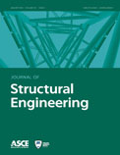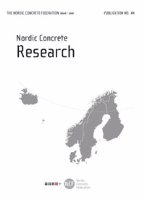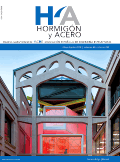
Computers and Concrete
Scope & Guideline
Bridging the Gap Between Technology and Concrete Solutions
Introduction
Aims and Scopes
- Computational Modeling in Concrete Engineering:
The journal emphasizes the use of advanced computational methods, such as finite element analysis (FEA) and discrete element modeling (DEM), to simulate and predict the behavior of concrete structures under various loading conditions. - Sustainable and Innovative Materials:
Research on sustainable concrete materials, including geopolymer concrete and the use of recycled aggregates, is a key focus, promoting environmentally friendly practices in civil engineering. - Machine Learning Applications:
The integration of machine learning techniques for predicting concrete properties and performance is a growing area, showcasing the journal's commitment to innovative technology in construction materials. - Structural Performance Assessment:
The journal includes studies on the structural performance of concrete under different conditions, including seismic performance, fire resistance, and durability, to enhance safety and reliability in engineering designs. - Forensic Engineering and Failure Analysis:
Research related to forensic engineering, including the investigation of failures and deterioration mechanisms in concrete structures, is a critical aspect of the journal's scope.
Trending and Emerging
- Integration of Artificial Intelligence:
There is a rising trend in utilizing artificial intelligence and machine learning for predictive modeling in concrete engineering, enhancing the ability to forecast material performance and optimize designs. - Performance-Based Design Methodologies:
Emerging methodologies that prioritize performance-based design over prescriptive approaches are gaining attention, reflecting a shift towards more dynamic and adaptable engineering practices. - Advanced Materials and Smart Concrete:
Research on smart concrete materials, including those embedded with sensors or capable of self-healing, is trending as engineers seek innovative solutions to improve the longevity and functionality of concrete structures. - Climate Resilience and Sustainability:
Increasing focus on climate resilience in concrete design highlights the importance of developing materials and structures that can withstand extreme weather conditions, aligning with global sustainability goals. - Digital Twin Technology in Construction:
The application of digital twin technology for real-time monitoring and management of concrete structures is emerging, representing a significant advancement in the intersection of digital engineering and construction management.
Declining or Waning
- Traditional Concrete Testing Methods:
Research focusing solely on traditional laboratory testing methods for concrete properties has waned as computational and machine learning techniques gain traction, indicating a shift towards more innovative and efficient approaches. - Standardized Design Approaches:
The emphasis on conventional design approaches for concrete structures is decreasing, reflecting a growing preference for more adaptable and performance-based design methodologies that incorporate advanced simulations. - Basic Material Properties without Contextual Applications:
There is a noticeable decline in studies that report basic material properties of concrete without linking them to specific applications or advanced computational modeling, as the field moves towards more application-oriented research.
Similar Journals

Frontiers of Structural and Civil Engineering
Fostering Collaboration for Engineering ExcellenceFrontiers of Structural and Civil Engineering, published by HIGHER EDUCATION PRESS, is a premier academic journal dedicated to advancing the fields of architecture, civil, and structural engineering. With an ISSN of 2095-2430 and E-ISSN of 2095-2449, this journal caters to the dissemination of high-quality research and innovative practices from 2012 onwards, highlighting important developments up until 2024. Ranked in the top quartile (Q1) for Architecture and Q2 for Civil and Structural Engineering in 2023, it holds an impressive Scopus ranking of #19 out of 189 in Architecture and #101 out of 379 in Civil and Structural Engineering, reflecting its impact and relevance in the scientific community. This journal invites contributions that demonstrate pioneering approaches, fostering collaboration among researchers, professionals, and students alike, and significantly contributes to the global knowledge base in the engineering disciplines.

JOURNAL OF STRUCTURAL ENGINEERING
Transforming Ideas into Structural SolutionsThe JOURNAL OF STRUCTURAL ENGINEERING, published by the ASCE-AMERICAN SOCIETY OF CIVIL ENGINEERS, is a premier academic journal that focuses on the latest advancements in the field of structural engineering. With a rich history dating back to 1955, this journal has become a crucial platform for disseminating peer-reviewed research that addresses critical issues and innovative solutions in building and construction, civil and structural engineering, materials science, and mechanics. It proudly holds a Q1 quartile ranking across multiple categories in the 2023 Scopus rankings, indicating its influential presence in the academic community. The journal does not currently offer open access options, ensuring that the content is rigorously vetted for quality and relevance, thus appealing to researchers, industry professionals, and students seeking credible, impactful research. With contributions from leading experts, the JOURNAL OF STRUCTURAL ENGINEERING is essential reading for anyone interested in advancing their understanding and practice within this vital area of engineering.

ACI MATERIALS JOURNAL
Connecting Theory and Practice in Concrete InnovationWelcome to the ACI Materials Journal, a premier publication in the field of materials science and engineering, published by the American Concrete Institute. Since its inception in 1987, this journal has continually contributed to advancing the understanding of concrete materials and structures, playing a vital role in both academic and practical applications. With an impressive impact factor and consistently ranking in the Q1 category for Building and Construction and Civil and Structural Engineering, the ACI Materials Journal is recognized for its rigorous peer-review process and high-quality research contributions. It serves as a crucial platform for researchers, practitioners, and students, featuring articles that explore innovative materials, sustainable practices, and cutting-edge technology, all of which are essential for the future of the civil engineering domain. Although the journal is not open access, it remains accessible to a vast audience through institutional subscriptions.

ACI STRUCTURAL JOURNAL
Advancing Concrete Innovation for Tomorrow's StructuresThe ACI Structural Journal, published by the American Concrete Institute, serves as a premier platform for scholarly articles and research findings in the fields of building and construction and civil and structural engineering. With a commitment to advancing concrete technology and its applications, this journal has amassed an impressive reputation, holding a Q2 ranking in both Building and Construction and Civil and Structural Engineering categories as of 2023. The journal’s focus on innovative research and practical applications enables professionals, researchers, and students to stay at the forefront of industry developments. Although it does not offer open access, the content bears significant impact, ensuring that readers engage with high-quality research. As the journal converges its years of publication from 1987 to 2024, it continues to enrich the academic and professional discussions surrounding structural engineering and concrete science.

International Journal of GEOMATE
Shaping the future of engineering with cutting-edge insights.The International Journal of GEOMATE, published by GEOMATE INT SOC based in Japan, is a pivotal resource for scholars and practitioners in the fields of Building and Construction, Environmental Engineering, Geotechnical Engineering, and Soil Science. Established in 2011 and continuing to set the standard in its focus areas, this journal serves as a platform for innovative research and practical applications, with contributions that significantly enhance the understanding and development of sustainable engineering practices. With its current classification in the Q3 quartile across multiple categories, it strives to disseminate critical knowledge and foster dialogue among a diverse audience, including researchers, industry professionals, and students. Though operating under a traditional subscription model, the journal's emphasis on rigorous peer review and high-quality publications ensures a substantial impact factor, further reinforcing its reputation in academia. Spanning from 2011 to 2024, the International Journal of GEOMATE invites contributions that advance the knowledge frontier and address contemporary challenges in engineering and environmental science.

Nordic Concrete Research
Transforming Research into Concrete SolutionsNordic Concrete Research is a prestigious journal dedicated to advancing the field of concrete technology and engineering, published by SCIENDO. With an ISSN of 0800-6377 and an E-ISSN of 2545-2819, this journal provides a robust platform for scholars, researchers, and industry professionals to share innovative research findings and insights related to concrete materials, practices, and applications. Since becoming an Open Access publication in 2018, it has enhanced accessibility for global readers, promoting wider dissemination of knowledge and collaboration across disciplines. The journal's commitment to excellence in scholarly communication is evident as it invites contributions that address both fundamental and applied aspects of concrete science, supporting the continuous evolution of this essential material in sustainable construction practices. Situated in Warsaw, Poland, Nordic Concrete Research not only serves the Nordic region but also aims to impact the international concrete community.

STRUCTURAL ENGINEERING AND MECHANICS
Innovative Studies for the Modern EngineerSTRUCTURAL ENGINEERING AND MECHANICS, a leading journal published by TECHNO-PRESS, stands at the forefront of research in the disciplines of civil, structural, and mechanical engineering. With an ISSN of 1225-4568 and an E-ISSN of 1598-6217, this South Korea-based journal has been a significant contributor to the academic community since its inception in 1994, and it continues to disseminate vital research through 2024 and beyond. Achieving a Q3 ranking in key categories such as Building and Construction, Civil and Structural Engineering, Mechanical Engineering, and Mechanics of Materials, the journal is recognized for its high standard of academic rigour and relevance in contemporary engineering challenges. Although not Open Access, it offers robust access options for institutions and professionals seeking to advance their understanding of structural systems and mechanics. Researchers, students, and practitioners in these fields will find invaluable insights and innovative studies that push the boundaries of knowledge, making this journal an essential resource for anyone invested in engineering advancements.

Hormigon y Acero
Innovating Concrete and Steel SolutionsHormigon y Acero, an esteemed journal published by the ASOC ESPANOLA INGENIERIA ESTRUCTURAL-ACHE, serves as a vital resource in the fields of structural engineering and construction. With an ISSN of 0439-5689 and an E-ISSN of 2605-1729, this journal plays a critical role in disseminating innovative research and advancements from 2019 to 2024, particularly focusing on concrete and steel applications. Although it does not currently offer open access, its contributions remain invaluable to professionals and academics seeking to enhance their understanding and practices in engineering disciplines. Ranked within the 13th percentile in Building and Construction and the 9th percentile in Civil and Structural Engineering according to Scopus, Hormigon y Acero is recognized for its rigorous peer-reviewed content that addresses contemporary challenges and innovations within the industry. The journal is positioned in Madrid, Spain, and aims to foster collaboration and knowledge exchange among researchers, practitioners, and students dedicated to the advancement of structural engineering.

Revista de la Construccion
Advancing Civil Engineering Knowledge for a Sustainable FutureRevista de la Construcción is a pivotal academic journal dedicated to the field of civil engineering and construction, published by the prestigious Pontificia Universidad Católica de Chile, Escuela de Construcción Civil. With its ISSN 0718-915X, this journal serves as a crucial platform for disseminating innovative research, case studies, and advancements in construction methodologies that address contemporary challenges within the industry. While currently not classified as open access, it provides valuable insights benefiting researchers, professionals, and students engaged in construction development and sustainability. The journal enhances the academic discourse and contributes significantly to knowledge in engineering practices, project management, and material science. Based in Santiago, Chile, the journal aims to foster collaboration and knowledge exchange among experts both locally and globally, making it an essential resource for those striving to advance the science and practice of construction.

International Journal of Concrete Structures and Materials
Unlocking Solutions for Tomorrow's Engineering ChallengesThe International Journal of Concrete Structures and Materials, published by SPRINGER, is a premier open-access journal dedicated to the field of civil and structural engineering, with a strong emphasis on concrete materials and their diverse applications. With an ISSN of 1976-0485 and E-ISSN of 2234-1315, this journal has established itself as a crucial resource since its inception in 2012, addressing pressing challenges in structural integrity and durability. With a remarkable impact factor and ranking in the Q1 category for both Civil and Structural Engineering and Ocean Engineering, this journal has garnered recognition and respect, ranking #18 out of 105 in Ocean Engineering and #81 out of 379 in Civil and Structural Engineering as per Scopus metrics. The journal’s open-access policy enhances the dissemination of knowledge, making cutting-edge research readily available to a global audience. Aimed at researchers, practitioners, and students alike, the International Journal of Concrete Structures and Materials strives to promote advancements in concrete technology and foster innovative solutions for contemporary engineering problems.